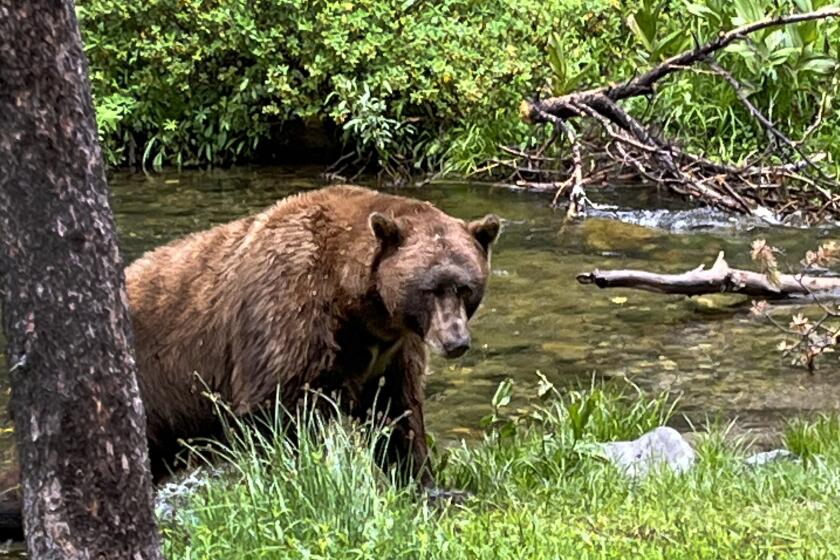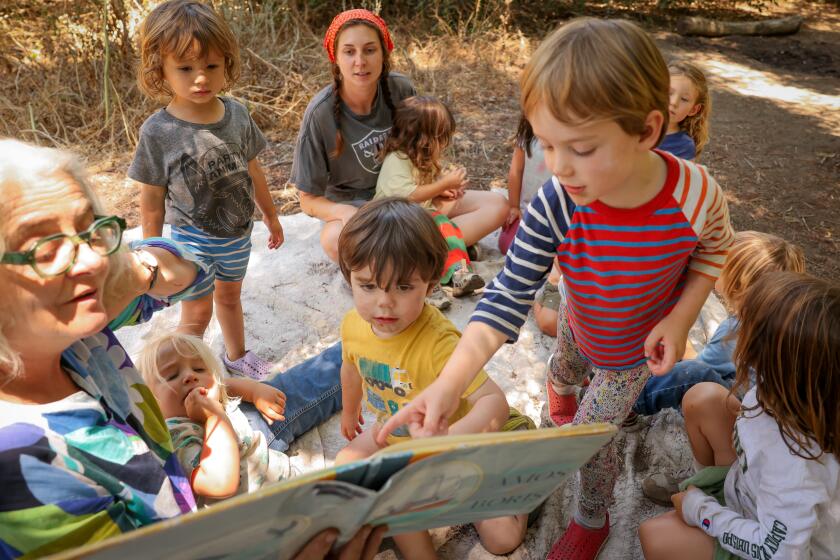
- Share via
One way to tackle the unequal distribution of trees across Los Angeles is to plant more of them in places lacking a robust canopy, like East and South L.A.
But a new study helmed by USC and the South L.A. Tree Coalition suggests the solution will need to be more multifaceted after decades of environmental injustice.
And with the budget for the city’s Urban Forestry Division slashed by over $1 million this year, progress toward equity could be stymied.
Victor the bear was notorious for mooching meals at Mammoth Lakes campgrounds, but when he crashed a steak and wine dinner, things escalated quickly.
Participants in the study, “Rooted Connections: Understanding South Los Angeles Community Leaders’ Relationship to the Urban Forest,” expressed an awareness of the harms caused by tree disparity and the value of a cooling canopy.
But they also raised complex concerns about how urban greening fits in with other pressing issues like homelessness and gentrification and called for adequate planning and maintenance.
“Our lack of trees is not an accident or coincidence. It is a result of historic patterns of discrimination, disenfranchisement and racist planning practices,” one South L.A. community leader said. “And so there is no easy fix. I think this is the first challenge. And I think because it’s such a big problem, it’s going to take a big sort of solution.”
Participants were not named in the study.
Previous research has laid bare the stark disparities of tree cover in Los Angeles.
Five areas within census tracts — one in Pacific Palisades, one in Los Feliz, two in Brentwood and one in Shadow Hills — contain 18% of the city’s total tree canopy coverage, but less than 1% of residents live in these areas, according to a 2019 assessment.
While L.A.’s average canopy cover is 21%, South L.A.’s is 13%, falling to just 5% in some areas, the authors of “Rooted Connections” report.
The new study seeks to represent the views and perspectives of South L.A. community leaders and stakeholders, or those who might be affected by a sparse canopy.
Fires could encroach on critical habitat for the endangered Southern California mountain yellow legged frog.
Tapping leaders “is what makes this really unique,” said Theresa Maysonet, co-founder of the South L.A. Tree Coalition.
One of the overarching goals was to elevate voices of the affected community to inform future policy and planning, including by the Coalition. The area examined in the study included the neighborhoods of Athens, Compton, Crenshaw, Florence, Hyde Park, Lynwood, Paramount and Watts.
“What can sometimes happen at the community level is that things can be dismissed, right? Because an elected official may say, ‘Oh, OK, you’re the only one that has that issue,’ and try to sort of see it as a one-off. Or they can be, maybe, not taken as seriously,” said Santina Contreras, assistant professor at the USC Sol Price School of Public Policy and the study’s lead author.
Researchers interviewed 34 people over Zoom and distilled their responses into three key findings.
- Trees in South L.A. play a role in community leaders’ perceptions of neighborhood identity and environmental conditions, as well as public health and safety.
- Competing priorities, limited resources and lack of awareness present barriers to tree-related planning efforts in the community.
- Community leaders value a healthy tree canopy in South L.A. and envision a future with equitable and intentional greenery supported by community initiatives and proper maintenance.
A section breaking down the first key finding notes that participants highlighted adverse health effects due to lack of trees, illustrated by a comment: “So you’ve got long-term impact[s] as well, which is more heat, which can have physical and mental impacts on people in South L.A., as well as the long-term impacts of just not being in an environment where there’s necessarily like amelioration of anxiety and stress.”
Researchers in the same section point to connections made between gentrification concerns and tree planting, including a participant remark, “I’ve also heard [people] say, ‘When we see white people coming in and planting trees, we know the rents are going up.’ So trees, on some level, represent gentrification, and gentrification means that they are going to have to leave.”
Contreras underscored the notion of how trees compete with other priorities in areas lacking resources as an important takeaway that often isn’t discussed.
Proponents of ‘forest schools’ say children immersed in nature are happier and healthier — and may be poised to become the next generation of climate warriors.
“Communities definitely want trees and they deserve trees, but they’re also navigating how to advocate for them when there are lots of different issues and challenges that they’re facing, in terms of trying to build up their cities in the most effective way,” she said.
“To a certain extent, we would love to just talk about trees and, you know, that’s the No. 1 priority. But that’s not necessarily the reality for communities … at least for the people that we interviewed.”
The South L.A. Tree Coalition, which secured a grant for the study, worked hand in hand with its academic partners, identifying participants and shaping the interview. Contreras said it was guided “really, truly from what communities want.” The USC Dornsife Public Exchange, which links university researchers to public and private sector leaders, was also a partner.
Maysonet, a West Adams resident who sits on the United Neighborhoods Neighborhood Council, said she hopes all L.A. City Council members see the report because “it affects the entire city.” According to the recent study, nine of the 15 council districts have less than 25% tree coverage, which is under the 30% recommended by experts.
“We would like for [Mayor Karen Bass] to see the report and understand the importance of funding to correct some of these historic and systemic planning practices,” Maysonet said.
Yet funding is being pulled back amid a bad budget year. StreetsLA — which handles sidewalk repair, street sweeping and tree maintenance among other things — saw a budget reduction of $21.4 million for the 2024-25 fiscal year, according to a July presentation by StreetsLA’s Ana Tabuena-Ruddy, assistant director and chief sustainability officer, to the city Community Forest Advisory Committee.
StreetsLA’s Urban Forestry Division, which manages roughly 700,000 street trees along 6,500 miles of public roads, lost $1.1 million.
“Budget challenges have impacts to tree preservation, ability to provide tree establishment, care, enforcement and responding to year-round, tree-related emergencies,” which have increased due to climate change and lack of maintenance, Tabuena-Ruddy told the committee that includes community representatives from each council district as well as a mayor’s representative. Maysonet is an alternate for Council District 10.
“Due to decreased resources for planting, our planting strategy must take a targeted approach, emphasizing equity,” Tabuena-Ruddy said later in the presentation.
The forestry division has identified areas most in need of canopy cover help. Council District 9, which stretches from the southern tip of downtown L.A. through the USC campus and deep into South L.A., “needs a lot of focus in terms of tree planting,” she said.
Tabuena-Ruddy said the forestry division will provide an equal amount of money across council districts, but that a portion of funding will need to be used for an equity-based approach.
“There’s not much to go around,” she said.
Dan Halden, senior advisor of external relations for StreetsLA, said the city has invested in technology to guide its equity-focused efforts, including TreeKeeper8 and what he described as a “forthcoming, upgraded asset management system to identify readily available planting opportunities within historically underserved areas.”
In a statement, he said partnerships with nonprofit and community organizations are necessary for the city to achieve its “goal of a healthy, maintained tree canopy that provides much-needed shade, particularly in disadvantaged communities.”
“The city is eager to continue and expand its partnerships with community organizations like the South L.A. Tree Coalition, and to collaborate on growing the tree canopy in South L.A. and beyond,” he said.
Toward a more sustainable California
Get Boiling Point, our newsletter exploring climate change, energy and the environment, and become part of the conversation — and the solution.
You may occasionally receive promotional content from the Los Angeles Times.










